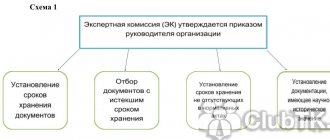Each organization accumulates a huge number of different documents in the course of its work. In order to systematize them, to “sort them out,” there is a special document called “Nomenclature of Cases.”
Today, its maintenance is not strictly mandatory, however, it has a certain distribution. Typically, the nomenclature of cases is used in large enterprises that have a branched structure, many divisions and, as a result, large document flow; small firms use it depending on the need.
- Form and sample
- Free download
- Online viewing
- Expert tested
FILES
Normative base
“Basic Rules for the work of archives of organizations” (approved by the decision of the Board of Rosarkhiv dated 02/06/2002)
Federal Law of 10/22/2004 N 125-FZ “On archiving in the Russian Federation”
Order of the Ministry of Culture of Russia dated March 31, 2015 N 526 “On approval of the rules for organizing the storage, acquisition, recording and use of documents from the Archive Fund of the Russian Federation and other archival documents in government bodies, local governments and organizations”
Order of the Ministry of Education and Science of Russia dated October 17, 2013 N 1155 “On approval of the federal state educational standard for preschool education”
Order of the Ministry of Culture of Russia dated July 31, 2007 N 1182 “On approval of the List of standard archival documents generated in the scientific, technical and production activities of organizations, indicating storage periods”
Order of the Ministry of Culture of Russia dated August 25, 2010 N 558 “On approval of the “List of standard management archival documents generated in the process of activities of state bodies, local governments and organizations, indicating storage periods”
Federal Law of December 6, 2011 N 402-FZ “On Accounting”
A case is a separate document or a set of documents that relate to one issue and are placed under one cover. And the order of distribution of individual documents into cases is determined by the nomenclature of cases. In office work, the basis for systematizing documents is their correct classification for placement in the appropriate files.
Why do you need a list of cases?
The main purpose of the nomenclature of cases is to systematize document flow. According to paragraph 3.4 of the “Basic Rules for the Operation of Organizational Archives” (approved by the Decision of the Board of the Federal Archives of 02/06/2002), the nomenclature of files is a list compiled in a certain form of the names of files entered into the records management of an enterprise, indicating their storage periods. We will provide a sample list of the organization’s affairs for 2020 below.
Main objectives of the document:
- classification and accounting;
- making it easier to find the necessary papers;
- assistance in transferring cases and drawing up inventories;
- systematic preparation of working documents for selection for further storage or destruction.
For whom is it required?
In the modern world, office work is a systematic approach and accuracy. If the list of cases is drawn up in a high-quality manner, then you can work with documentation in the institution quickly. Nowadays, the presence of a list of cases is mandatory for any legal entity, i.e. institution, organization, enterprise. Consequently, not only those employees who are responsible for internal document flow, but also managers of all ranks should know what the nomenclature of cases is.
Now let's talk about who must compile such a list. First of all, this should be done by enterprises that transfer papers to the state archive (clause 2 of article 20 of the Federal Law of October 22, 2004 No. 125-FZ “On Archiving in the Russian Federation”, the introductory part of the Basic Rules for the Operation of Archives of Organizations, approved by the Decision of the Board of the Federal Archives of 02/06/2002):
- state and municipal;
- non-state in terms of documents classified as state property;
- non-state, if they have concluded an agreement with the state archive.
Other companies do not have to do this. But it is desirable. It is better to have a sample nomenclature of an organization’s affairs for 2021, because it helps to systematize office work, as well as ensure the safety of archival documents. These include, in particular, personnel documents that are created in any company, and for the absence of which the company risks receiving a fine under Article 5.27 of the Code of Administrative Offenses of the Russian Federation.
Penalties for missing a name on a check
The penalty for generating a check without nomenclature is:
- for officials - from 1,500 to 3,000 rubles;
- for organizations - from 5,000 to 10,000 rubles.
In addition to fines, the generated fiscal document without the name of the product will be considered invalid, and you will have to somehow regulate the relationship with the buyer, since the transaction will essentially be considered terminated.
The tax office looks at the check details, so you need to be careful.
Kinds
The nomenclature of cases is of three types:
- standard (this is a normative document that determines the composition of cases processed in similar organizations);
- approximate (determines the approximate composition of cases and their indexes in the organizations to which it applies);
- individual (each company develops it independently, taking into account the approximate and standard one).
In companies that do not have structural divisions, one nomenclature is compiled. It indicates the titles of all cases opened in the company during the calendar year. At large enterprises, each structural division has its own, and later they are combined.
Where to store
The company determines the number of required copies of RD independently. For example, an institution has identified the following storage locations:
- The first copy is kept in the office.
- The second is used in the work of a company clerk or in the office department.
- The third is used in the company archive.
- The fourth was transferred to the state archive when the documentation was deposited.
- The remaining copies were transferred to the structural divisions of the organization for use in their work.
Procedure for formation and approval
For the first time, the nomenclature of cases should be developed at the very beginning of the organization’s activities. It is possible in the process of activity, but this is not entirely convenient: by the time this decision is made, a significant amount of working documentation will have accumulated, which will have to be sorted out. At the end of each year, the list of cases may be revised if necessary. In this case, changes, additions or exceptions are made to it, after which it is applied in an updated version from the beginning of the new period (clause 3.4.6 of the Basic Rules for the Operation of Archives). That is, a sample list of cases for 2021 with new storage periods should be approved at the end of last year or at the very beginning of this year.
Development is usually entrusted to the documentation support department, the office of the enterprise, or, if the enterprise is small, to a personnel officer, accountant or secretary. If necessary, you can turn to Rosarkhiv employees for help (clause 3.4.2 of the Basic Rules for the Operation of Archives).
The nomenclature is based on papers characterizing the features of the company’s activities and structure, previous nomenclatures, as well as lists of standard documents generated during the company’s activities.
When developing a nomenclature of cases, it is necessary to take into account:
- documents on the creation of the organization (regulations, charter);
- documents regulating the activities of structural divisions;
- staffing schedule;
- list of cases from previous years;
- organization registration form;
- standard and departmental lists of documents indicating storage periods.
Let us list the main stages of its approval:
- developed by a department of the organization;
- signed by the head of the unit;
- approved by order of the head of the enterprise. You can download the order on approval of the list of cases (sample) below.
Sample order for approval of the list of cases
How to form a name
You can start from several documents, depending on whether you produce the product yourself or simply sell it.
- If you are simply selling a product, then it is enough to focus on the full name of the product on the label from the manufacturer.
- If you produce a product or provide services, then the issue of the name must be resolved independently. Reference books will help you with this: the all-Russian classifier of products by type of economic activity (OKPED) and the technical regulations of the customs union. These directories do not contain specific names of GWS, but there are names of groups of goods and services that will help determine what words the name should consist of.
- When forming the name of a product or service, you can rely on experience and expertise.
How to name a service
Here, in addition to the same requirements that apply to goods, specific rules apply:
- A unique service must have a unique name. That is, the buyer must distinguish one service from another by name.
- The length of the name should not exceed 128 characters.
- If at the time of payment for the service you know exactly the volume and list of services that you will provide, then the name of the specific services must be reflected in the receipt. And if necessary, then their quantity, price per unit.
Examples with the name of the service on the receipt
At the time of payment it is clear what services will be provided
A client comes to a barbershop and orders a haircut and beard styling. At the time of payment, you already know exactly what services were provided. Therefore, you should not have problems with the names on the check. You can indicate both services and prices for them: “men’s haircut with a clipper” and “beard modeling”.
The client goes to a medical clinic and makes an appointment with a specific specialist at the reception desk. At the time of payment, the receipt can indicate exactly which specialist the client will go to and the price: “visit to a therapist.”
At the time of payment, the scope and list of services cannot be determined
The client pays for six months of training, but it is still unclear what specific services will be provided to him and what he will be taught. In this case, you can use a more general name; it is enough to indicate it as follows: “tuition payment.”
Prepayment or advance payment is made
This payment scheme is used in cases where it is impossible to determine the volume of services and goods and it is unclear what services will be provided.
To work correctly with advances and prepayments, you need to generate two checks.
The first check is generated when the money is transferred, that is, the buyer makes an advance payment. You generate the first check with the payment attribute “advance” and indicate the amount accepted from the client.
When you transfer goods to a buyer or provide services, you issue a second check with the payment attribute “full payment”. It must indicate the entire list of goods or services, their quantity, and unit price. When you deposit the amount received from the buyer, you indicate that part of the amount was received through an advance payment (indicate the amount from the first check), and, if necessary, indicate how much the buyer paid you extra.
Document structure
The unified form of the nomenclature of the organization’s affairs is contained in Appendix No. 24 of Order of the Ministry of Culture of Russia dated March 31, 2015 No. 526 (registered with the Ministry of Justice of Russia on September 7, 2015 No. 38830).
According to the Basic Rules for the Operation of Archives of Organizations, approved by the Decision of the Board of Rosarkhiv dated 02/06/2002, the nomenclature should indicate:
- Index.
- Name.
- Number of storage units - measured in volumes, this column is filled in after the end of the calendar year.
- The storage period and the number of articles on the list are an indication of how long the file should be stored, with reference to the normative act that sets this period.
- Note. To be filled in as needed.
Compilation rules
Despite the somewhat “cumbersome” name, this document has a fairly simple and understandable structure. Today there is no unified model, so enterprises can write it in any form, adding the necessary sections and paragraphs. However, there are some information that must be included in it:
- name of company,
- number and date of compilation,
- list of documents,
- signatures of responsible persons.
The document should also note the number of volumes that a particular file has, and whether it is maintained in electronic or paper form. If the case is conducted electronically, page numbering must be done by file and the same value must be noted in the nomenclature.
It should be noted that some organizations record those matters that are conducted electronically in a separate section of the document or create a separate nomenclature for them.
How to fill out the form
What was above is abstract information. Now we will show specifically what the list of cases in a preschool educational institution should look like for 2021 according to the Federal State Educational Standard, a sample of which can be downloaded for free below.
Let's start with the fact that the Federal State Educational Standards are federal state educational standards. In relation to preschool educational institutions, this is Order No. 1155 of the Ministry of Education and Science of Russia dated October 17, 2013, which reveals this standard in detail. If we look into it, we will see four sections, the first of which is general provisions. It is not relevant to our question. But the other three can be hired based on requirement:
- to the structure of the educational program;
- terms of implementation;
- results of mastering the program.
That is, our nomenclature will consist of at least three items (actually more, but more on that later).
Let's assign an index and name to each case.
Case index according to the nomenclature of cases (sample):
- 01 - structures of educational programs;
- 02 - progress in the implementation of educational programs;
- 03 — results of mastering educational programs.
Next, if we do it for a specific department, then we will assign a further index to this department, for example, the office index - 01. It will appear before the case number, because the weight of the department index is higher (it’s easier to search). As a result we get:
- 01-01;
- 01-02;
- 01-03.
Now, when filling these folders with specific documents, we will assign them numbers using a slash or a line:
- 01-01/… we start from one until the end of the year;
- 01-02/…;
- 01-03/….
The nomenclature of cases in the preschool educational institution for 2021 with new storage periods must be approved no later than the beginning of the new calendar year.
Sample list of cases for 2021
WE ASSIGN AN INDEX TO DIVISIONS
The case index usually consists of two parts, the first of which is the index of the division by nomenclature, the second is the serial number of the case within the nomenclature section. For example, 03-15, where 03 is the department index and 15 is the case number (see Examples 2–5).
If indexing was done previously:
• You need to decide whether to continue using this system or cancel it and install new indexes. It depends on which departments use them and how relevant the indexes are.
• A reasonable compromise would be to update the indexing system while maintaining the numbers assigned to the departments using the indexes.
• If the previous indexing system is quite relevant, then there is no point in changing it. In this case, a list of cases is created on its basis.
If until now the organization has managed without indexes of structural divisions, then the divisions will receive numbers in the general order at the next stage of working with the nomenclature of cases.
Determination of storage periods
The retention period is the main criterion for separating papers into cases. During the process of formation, cases are sorted into those subject to storage according to the following periods:
- temporary up to 10 years;
- temporary from 10 years;
- permanent.
Storage periods are determined according to approved lists:
- the main one is the “List of standard management archival documents...”, approved by Order of the Ministry of Culture of the Russian Federation dated August 25, 2010 No. 558;
- The storage periods for technical documentation are contained in the “List of standard archival documents...” approved by Order of the Ministry of Culture and Mass Communications of the Russian Federation dated July 31, 2007 No. 1182.
If you do not find the information you need in the sources provided, the company can set a retention period itself.
As for accounting and tax documents (the nomenclature of accounting files for 2021 with new storage periods), the procedure for their storage, destruction and liability for violations is prescribed by law in the Tax Code, Order of the Ministry of Culture of the Russian Federation dated August 25, 2010 No. 558 and the law dated October 22. 2004 No. 125-FZ “On archiving in the Russian Federation” and dated December 6, 2011 No. 402-FZ “On accounting”.
The storage of HR department documents is also regulated by law in the Code of Administrative Offenses of the Russian Federation. The nomenclature of HR department files for 2021 with new retention periods must be compiled by a specially appointed employee, executed by order and approved by the head of the organization.
Where is it stored?
Each instance has its own storage location:
- the first copy is placed in the file and stored with document specialists;
- the second is used in work;
- the third is an accounting document in the archive of the enterprise, if there is one;
- the fourth, after approval, remains in the state archive (if approval is necessary);
- the remaining copies are sent to structural units.
Consolidated list of cases, sample
Let us separately dwell on the case when documents need to be submitted to the archive.
Such cases are prepared for submission in accordance with the requirements of the State Archives. A year after the completion of office work, files of permanent and temporary storage are transferred to the archive of the organization. This process takes place according to a schedule approved by management. Cases are accepted according to inventories and nomenclatures with registration cards attached to the documents. If for current work it is necessary to leave some of the files, then the archive issues the issuance of these files for temporary use. Preparing files and submitting them to the archive includes conducting an examination of the scientific and practical value of documents, registering files, drawing up inventories of files with permanent and long-term storage periods.
Results
Archiving documents is the responsibility of any organization. The transfer of cases to archival storage is carried out in accordance with the developed nomenclature of cases. It is recommended to develop a nomenclature of cases according to the current rules approved by Rosarkhiv.
Sources: Law “On Archiving in the Russian Federation” dated October 22, 2004 No. 125-FZ
You can find more complete information on the topic in ConsultantPlus. Free trial access to the system for 2 days.
Examination of the value of documents
As a rule, the information in most documents has a one-time value and after use loses its relevance. And documents containing scientifically and practically valuable information must be stored permanently. For the optimal selection of valuable documents, an examination is carried out from the standpoint of determining the state, socio-cultural and other significance of documents in order to select them for state storage or to establish the terms of their storage. The commission is created by order of the head from the most qualified specialists, as well as the head of the office, departmental archive and chief accountant. The main tasks of the expert commission are: review of draft classifiers and office work nomenclatures.
Design rules
There are no strict rules for document formatting, which means that it can be maintained either manually or in printed form. The second option is more convenient, since the document often has a fairly impressive volume, and it is much more convenient to compile it and make edits. The document can be drawn up on standard blank A4 sheets or on the organization’s letterhead.
If the form contains several sheets, they should be stapled together, numbered and properly stamped at the end, indicating the date of compilation, noting the number of pages and verifying everything with the signature of the responsible person.
The document is drawn up in a single copy, which, after losing its relevance, is transferred for storage to the enterprise archive.






